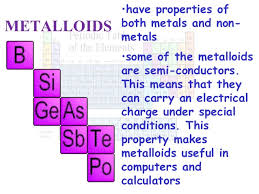Overview
Metalloids are elements that have some properties of metals and some of nonmetals. They are on the periodic table along the dividing line between metals and nonmetals. The most commonly recognized metalloids include the elements boron (B), silicon (Si), germanium (Ge), arsenic (As), antimony (Sb), and tellurium (Te).
Metalloids
Elements are commonly classified as either metals, nonmetals, or metalloids. Most metalloids are brittle (a non-metallic property), act as semiconductors of electricity, and have a metallic luster (also a metallic property). They are solid at room temperature. In chemical reactions, they often act more like nonmetals, but they form alloys like metals. Whether elements are classified as metalloids or not depend upon the chemist’s decision. For example, polonium (Po), and astatine (At) are sometimes included in the list of metalloids, because of their chemical properties and their location on the periodic table.
Semiconductor Properties
Metalloids are good semiconductors, which mean that they are between the electrical conductivity of metals and materials used for insulation. Semiconductors can conduct electricity under some conditions, so electrical current can be controlled. Semiconductor chips, transistors, and other electronic parts form integrated circuits for everything from computers to cell phones. The metalloids, especially silicon, boron, germanium, and compounds of arsenic and antimony, are natural semiconductors. Silicon and germanium revolutionized the electronics and computer industries.
Alloys
The metalloids are often too brittle to be used as pure substances, but form many useful alloys. For example, boron is used in alloys with steel and with nickel for welding components. Germanium is alloyed with silver to make tarnish-resistant sterling silver. Pewter is an alloy of tin and antimony.
Other Uses of Metalloids
Many compounds of metalloids are highly toxic, such as those containing arsenic and antimony. However, other compounds can be used as disinfectants and antiviral agents. Compounds of boron are used as catalysts in many chemical reactions. Many compounds are used to form glassware, especially in chemical and industrial uses, such as optical fibers. Silicon and boron compounds are also used in fireworks, as they are less toxic than some other compounds.
Interested in science tutoring services? Learn more about how we are assisting thousands of students each academic year.
SchoolTutoring Academy is the premier educational services company for K-12 and college students. We offer tutoring programs for students in K-12, AP classes, and college. To learn more about how we help parents and students in Mount Juliet, TN visit: Tutoring in Mount Juliet, TN



